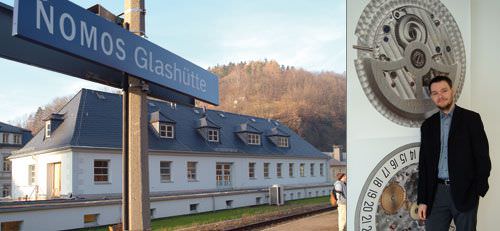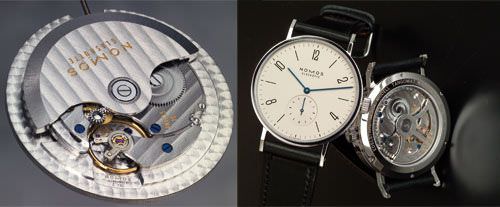The Glashütte watch brand Nomos recently moved to an old railway station. However, looking back on the history of the company, one assumes that this will only be one stop on the track to success. The next is stop is already in sight: Tangomat, the first automatic Nomos watch.
Nomos moved to the old railway station of Glashütte in March 2005 – and there is still a train connection from the town to nearby Dresden, but a complex station building is no longer needed.
Erected in 1937, it was totally renovated and changed by Klaus Schmitt, an artist from the Rhine area who is quite well known in Germany. Schmitt’s ambitions were to change the sinister building into a light, transparent place. The three-storey building now has a surface of some 1,200 square metres and is now equipped with the latest generation of tooling machines.

Railway station, Mirko Heyne

Nomos automatic movement, Tangomat Testuhr
Since the station had not been used for several years, Roland Schwertner, who founded Nomos in 1990, had maintained a close watch on the old building since the end of the nineties. In 2000 he purchased it for different reasons.
One reason was that due to the permanent increase of the staff, 54 employees today, Nomos simply needed more space. Another explanation, both emotional and commercial, was the site of building. Located on Ferdinand-Adolf-Lange-Platz 2, which is the main junction of Glashütte, the new Nomos headquarters literally stands in the horological heart of the small town with its 2,500 inhabitants.
Right across the street is the renovated home and workshop of the man whom the square is named after. (Ferdinand Adolf Lange founded the watch industry in Glashütte in 1845, then a small poor village with high unemployment.)
If you leave the former Railway station and turn left, you enter Altenberger Strasse and pass along the huge totally modernized building of Glashütte Original. Some 150 metres up the road you reach the headquarters of A. Lange & Söhne. So Nomos is today a neighbour of, and stands in line with, the most famous German watch brands.
But there is another common link between Nomos and its well-known competitors: like them, Nomos recently introduced its own automatic watch movement, totally constructed and mainly produced in-house – which is really something if you look back to the beginnings of this small, innovative, 15-year old watch brand. Back then, Nomos exclusively used ETA movements and was accused by its competitors of not being a ‘real’ Glashütte watch brand. They even went to court to try to force Nomos not to print the town’s name on the dial of its watches.
When Roland Schwertner started up at the beginning of the nineties, he had three employees and very little money. Since then, he has put his focus on the design of very pure, unisex stainless steel timepieces. Fortunately, he managed to make his brand popular rather quickly by using clever marketing campaigns and sales rose constantly. At the same time, watch lovers began to pay more attention to the technical aspects of the timepieces.
As the firm was able to invest the revenue from its satisfying turnover, the Nomos watchmakers started working on individual technical solutions – which were based on modified Swiss movements.
It was the young watchmaker Mirko Heyne, trained by A.Lange & Söhne and, afterwards a partner of the Dresden watch brand Lange & Heyne, who made Nomos turn away from the exclusive use of hand wound movements. Heyne joined the company at the end of 2002 in order to work in the Research & Development department. A couple of months later, he was asked by Roland Schwertner, to construct an automatic movement. By spring 2005, the first prototypes were offered to 250 people to make a ‘real life test’ wearing watches equipped with the new movement.
During the inauguration of the renovated railway station, a special press conference took place at which the first watch with an original Nomos automatic movement was presented. As a tribute to the most successful Nomos watch Tangente, the new timepiece was named Tangomat. “Nomos has grown up,” Roland Schwertner says, suggesting that his company should now be respected as a watch manufacture.
Since people enjoy dancing and Nomos is full of surprises, inevitably one is curious as to what the next ‘Nomos dance’ will be after the Tango.
Source: June-July 2005 Issue
Click here to subscribe to Europa Star Magazine.








